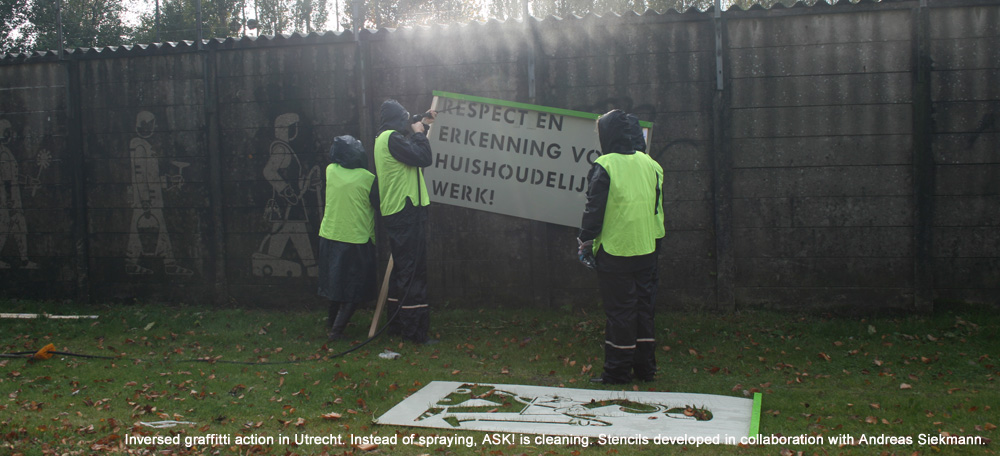“I think the artistic is like a double-edged sword.“
An Interview with Janna Graham, Nicolas Vass, and Annette Krauss by Laila Huber
In your practice, education and research also play an important role—how did this develop and why is it so central to your work? How do you understand, for example, research?
Annette Krauss: I am interested in institutions, although in many cases I dislike them; nevertheless, I find it necessary to work in them, with the somewhat utopian aim of transforming them. Institutional critique, as a kind of research into the production processes within and of institutional structures, is very helpful here, not necessarily as a self-referential artistic strategy, but more, for instance, using it for the work in education (at universities or secondary schools), and at the same time adding or commenting on the artistic understanding of institutional critique. What I am frustrated about is the somewhat hermetic split between institutional critique in art and the work on institutions in other fields, let’s say, education. They could be fruitful for each other and provoke synergies.
What I want to add here is that in the 1968 movement, for example, in Germany, institutional critique in the arts and in pedagogy was actually much more connected and thought of together than has been the case since the 1980s/1990s. We need to learn from connected movements in Argentina, Brazil. Now, when you hear or read about institutional critique, struggles around school education and critical pedagogy are rarely cited, and that is something that I find very interesting and unfortunate. I work as an artist, not only within the educational field and schools, but also with the aim of commenting on, if not intervening in a certain legacy within the art field. And hereby, I mean, which kind of legacy of institutional critique is visible. I think it would be much more enriching to many social fields if this homogenous arts critique were opened up and vice versa. I have learned a lot going through institutional critique and artistic practices, but also found other voices and practices that looked into and did critical work in institutions, such as schools or universities, not to forget self-organizing or what it is sometimes called, “alternative instituting.”
Janna Graham: I have a very similar history, working in a gallery at the moment when institutional critique was quite alive and at the same time having gone through training in popular education by indigenous activists and those who were involved in the Nicaraguan literacy movements. To me, the commitments in each of these practices seemed aligned, but also quite different, because institutional critique already focused very much on museums themselves by then, and not on broader social consequences. I wondered how this had come to be. Less positively, where I found real similarities between my work in the arts and in the more symbolic side of social movements, was that they often both adhered to the banking concept.*1 *(1) Popular education and popular research proposed a provocation to both of these fields: against the idea of a top-down-activism that tries to profess the message of the left on the one hand, and a museology that proposes to change the perspective of visitors by changing the content of its exhibitions on the other hand. Rather than asking “How can we get the people to like contemporary art?” or “How can we get people to agree with our analysis?” popular education re-positions the production of knowledge, culture, and politics in the collective investigation of conditions of power. But this kind of collective analysis requires time. Making use of the term research and the practices of popular education allow one to smuggle sustained commitments to social justice projects into the art world. The difficulty here is to mark the difference between conventional academic research and popular or militant research, because the resources of research in the university are still primarily funneled to academics, producing similar authorial problems to those encountered in the art world.
Annette Krauss: It is again the question, to which group are you talking or to which participants are you talking, when it comes to research? Are you talking to an academic community or are you talking to an arts community or art funding bodies?
Janna Graham: Or neither. At the Center for Possible Studies, the idea of the study or studying has been compelling for people that we work with. We say, this is a study, but no one is telling you where and what you have to study. It is about something you want to impact in the world. This is not the standard connotation of research. Over time, community groups have walked through the door of our space and said “I think I have a possible study.” So it is also important to reclaim some of these terms that have become relegated to particular domains, like the university, so that people feel that they can use them, like art-making, we all have a right to do research, we all do it every day.
Thank your very much for the interview!
Janna Graham, Nicolas Vass, Annette Krauss, Laila Huber ( 2014): “I think the artistic is like a double-edged sword.“. An Interview with Janna Graham, Nicolas Vass, and Annette Krauss by Laila Huber . In: p/art/icipate – Kultur aktiv gestalten # 05 , https://www.p-art-icipate.net/i-think-the-artistic-is-like-a-double-edged-sword/

